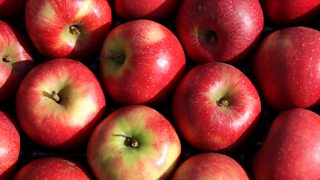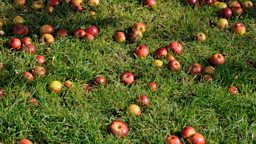Tell a Pig’s Nose from a Cat's Head with these cider facts
The Food Programme has been exploring the world of cider - they found that there are over 200 varieties of cider apple. With cider production in full autumnal flow, here are some other cider facts.

Britain has the biggest cider market in the world, followed by South Africa and the USA. But the biggest drinkers are the Irish - they drink almost 15 litres per person a year.
As well as the famous Hen’s Turd apple, you can make cider with apple varieties including Cat’s Head, Sheep’s Nose, Foxwhelp and Yellow Willy. The most widely planted cider apple is the Dabinett, while the Kingston Black is said by many to be the ‘king’. These cider apples differ from normal apples in being high in tannin and bittersweet. Bite and beware!
To make simple scrumpy or old leg-bender, all you need to do is crush and press your apples (harder than it sounds) add some yeast and leave to ferment. The natural sugars will turn to alcohol, but we can’t guarantee how good this will taste. Some professionals use the wild yeast on the apple skin, while others pasteurise. Always make sure your equipment is completely sterilised.
Can you tell cider from cyder?

Gabe Cook, a Ciderologist from the National Association of Cider Makers, clears up the confusion.

To be considered a cider, the drink needs to be at least 35% apple juice. Classier makers (never call them brewers) use up to 100%.
Perry cider is made from pears, much of it from the three counties region of Gloucestershire, Herefordshire and Worcestershire. Legend has it that this is because when the king of the gods lived on May Hill, an underling brought him a pear to taste. Expecting an apple, he spat it out in a giant circle all around. Pear orchards began to grow where all the pips landed in the soil.
-
![]()
The Food Programme: The C Word
A brewer's guide to modern cider.

Some cider makers don’t dilute their drink. Instead they double ferment, a lengthy process which requires the juice to be transferred after six months into full strength champagne bottles, and placed horizontally in a rack. After ten months they are turned daily by a quarter until inverted and the sediment can be removed from the top. This gap in the bottle is replaced by a ‘dosage’ of cyder and cane sugar, to a level champagne manufacturers would describe as brut or dry. The result is a super-sparkling drink unlike any cider you’ve ever tried.
To be considered a cider, the drink needs to be at least 35% apple juice. Classier makers (never call them brewers) use up to 100%.
The three biggest recent changes in the cider market, according to Westons cider in Herefordshire, have been: the arrival of white cider (high strength, low apple content); the Magners effect (cider from Ireland, served on ice); and fruit cider. Some purists object to the sweet non-cidery taste, but fruit cider is now 27% of all cider sold, and that share is growing fast.
-
![]()
The Food Programme
Jaega Wise of Wild Card presents a brewer's guide to modern cider.
-
![]()
How British is the apple?
The apple has a unique place both in Britain, and the world.
-
![]()
Why this tropical fruit is good for you
This pod-like fruit which contains an edible pulp is used in cooking around the world.
-
![]()
13 juicy facts about mangoes
Here are a few juicy titbits about the marvellous mango. Tuck in!




